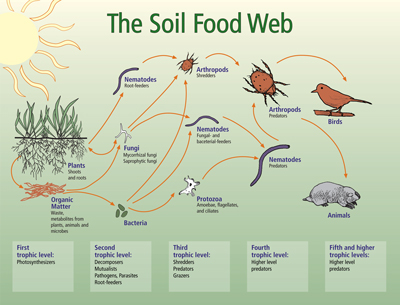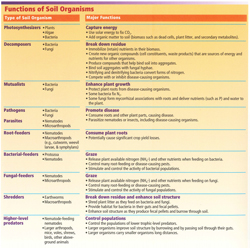Soil food web
The soil food web is a complex interaction between fauna and flora within the soil. These groups include bacteria, fungi, protozoa, nematodes, micro-arthropods, insects, small vertebrates, earthworms, and plants. Larger organisms are also a part of the system. Each specific element within the food web works together with chemical, biological, and physical forces within the environment to maintain healthy soils and monitor how it interacts with other flora and fauna. [1] It was first described in the academic literature of Dr. Elaine Ingham, a soil biology researcher, and microbiologist. [5]
Food webs are all the food chains within a single ecosystem with each food chain being a possible path of nutrients and energy as it is moved throughout the environment. [2]

Organisms and their Interactions
Each organism interacts with other species within the soil food web. Within a food web, there are trophic levels between each interaction ranging from the first tropic level to the fifth trophic level which dictates the roles occupied by that organism in the ecosystem. The first trophic level is primary producers, followed by primary consumers, secondary consumers, tertiary consumers, and apex predators. [7] Below are the different trophic level organisms and interactions present within the soil food web:
- Plants - The first trophic level, a primary producer. Nematodes and fungi feed into the shoots and roots of plants while organic matter, waste from plants, is created due to the decomposition of these plants.
- Bacteria - The second trophic level, a primary consumer. A part of decomposers and feeds off of organic matter produced by the primary producers, plants.
- Fungi - The second trophic level, a primary consumer. Feeds off of plants and organic matter.
- Nematodes - Three types of nematodes dependent on size. The first nematode is a primary consumer that feeds on the roots of plants. The second nematode is also a primary consumer but feeds on fungi and bacteria. The final nematode and the largest in size is the predator, which consists of the third trophic level, secondary consumers. These nematodes feed on other smaller nematodes and protozoa found within the soil.
- Arthropods - Two types of arthropods are found within the soil; shredders and predators. The shredders are a part of the third trophic level and feed on root-feeding nematodes, fungi, and bacteria. The predator arthropods are a part of the fourth trophic level, tertiary consumers. They feed on predator nematodes, and shredder arthropods.
- Fauna - This category of organisms consists of birds and animals. They are both at the fifth trophic level, the apex predators of the soil. They both eat predatory arthropods. [4]
Soil Food Web Functions

The organisms within the ecosystem existing in the soil depend on the interactions with each other to maintain survival and growth. In turn, these organisms support nutrient growth as they enhance soil structure, control populations of soil organisms, and decompose organic matter. [4] Below are some examples of soil food web functions present within the soil structure;
- Nutrient Cycling - The fecal excretion from predators such as protozoa and nematodes from the consumption of bacteria and fungi release nutrients. The plants in the soil then absorb these nutrients, causing the plant to flourish and enhance plant growth. [1]
- Bioturbation - This is a process in which plant residues mix into soils by biotic activity such as earthworms, pot worms, collembola, mites, and isopods. It regulates the flow of water and gas as well as dissolves nutrients within the soil. This process advances decomposition and creates habitats for another microfauna within the ecosystem. [6]
- Decomposition of organic matter - Decomposition within the soil is abundant among soil animals such as earthworms and termites. This decomposition process occurs by dispersing microbes throughout the soil by mincing organic material. These decomposers play a crucial role within the soil food web as it allows for waste management and pollution control within the ecosystem. [1]
- Capture of energy - Photosynthesizers within the soil such as plants, algae, and bacteria capture the energy and use solar energy to fix CO2. [4]
- Control of populations - Above-ground animals such as mice, shrews, birds, and larger nematodes control the population of lower trophic level predators. These larger organisms also improve soil structure by carrying smaller organisms large distances and burrowing. [4]
Soil Organisms Habitat
Organisms within the soil are not distributed evenly unlike other ecosystems present in our world. Rather, they live in 'hotspots' where much of the nutrients, and moisture are found regardless of the space available. They most often occur where the [[[Organic Matter]]|organic matter] is found and are within a range of a few inches of soil from the surface. Specifically, many organisms are found around roots. This zone is called the rhizosphere and consists of narrow areas of soil surrounding the roots and root hairs of plants found above the surface. These plant roots are abundant with bacteria that feed on proteins released by the roots and allow the plant to maintain a healthy root system due to nutrient cycling and disease suppression. Another hotspot of soil organism activity is within the litter of soils. Fungi are commonly found here as it is an area abundant with hard-to-decompose carbon. More hotspots consist of humus, on the surface of soil aggregates, and in the spaces between soil aggregates. [4]
References
[1] The Soil Food Web. RootShoot. (n.d.). Retrieved May 5, 2022, from http://www.rootshootsoils.com/the-soil-food-web
[2] National Geographic Society. (2012, October 9). Food web. National Geographic Society. Retrieved May 5, 2022, from https://www.nationalgeographic.org/encyclopedia/food-web/
[3] The soil food web: Nature's way to build healthy soils. Piedmont Master Gardeners. (n.d.). Retrieved May 5, 2022, from https://piedmontmastergardeners.org/article/the-soil-food-web-natures-way-to-build-healthy-soils/
[4] Natural Resources Conservation Service. Soil Food Web | NRCS Soils. (n.d.). Retrieved May 5, 2022, from https://www.nrcs.usda.gov/wps/portal/nrcs/detailfull/soils/health/biology/?cid=nrcs142p2_053868
[5] Admin, S. (n.d.). Symsoil admin. SymSoil. Retrieved May 5, 2022, from https://symsoil.com/soil-food-web-symsoil/
[6] Nakaya, R. (2021, January 27). Soil life in action: Bioturbation with and without soil fauna. The Kid Should See This. Retrieved May 5, 2022, from https://thekidshouldseethis.com/post/bioturbation-with-and-without-soil-fauna#:~:text=Bioturbation%20is%20the%20mixing%20of,water%20flow%20through%20the%20soil.
[7] Take online courses. earn college credit. Research Schools, Degrees & Careers. Study.com | Take Online Courses. Earn College Credit. Research Schools, Degrees & Careers. (n.d.). Retrieved May 6, 2022, from https://study.com/learn/lesson/trophic-levels-structure-function.html